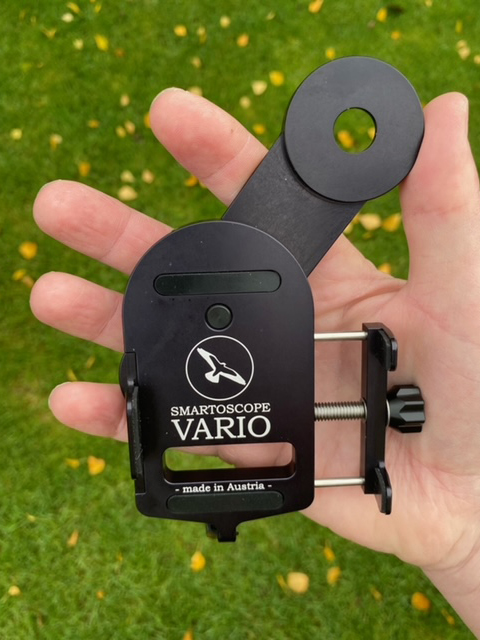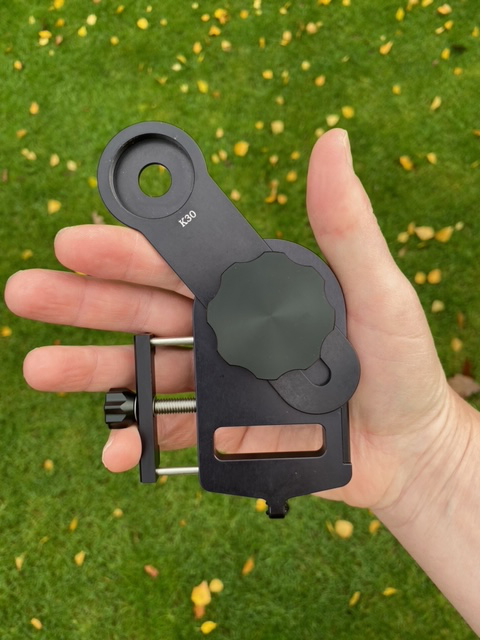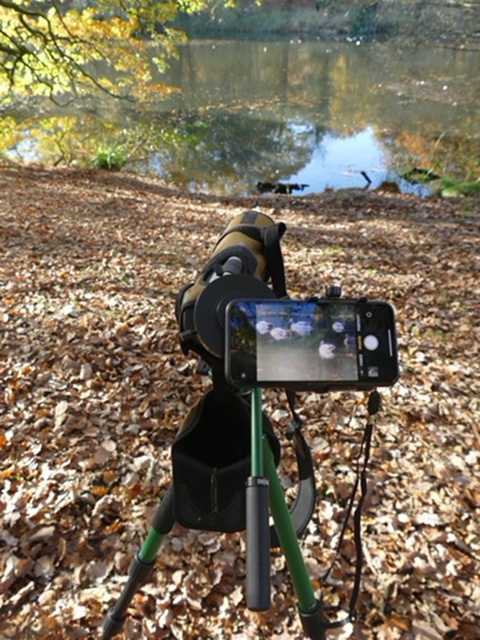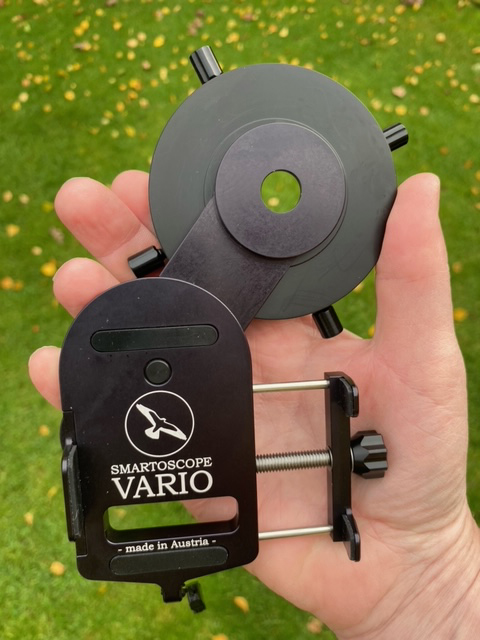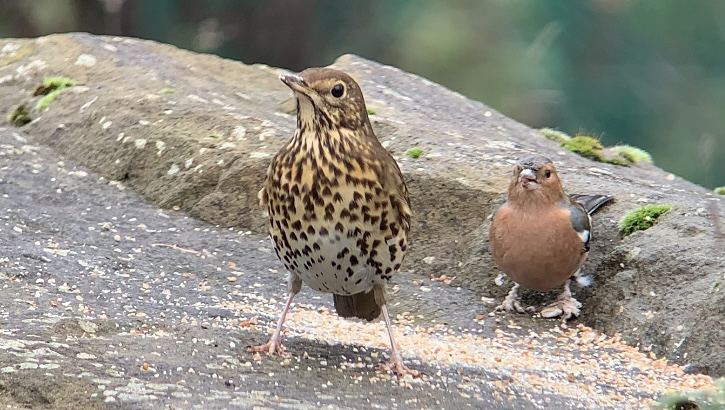Ultimate Smartoscope Vario-Adapter Review
Digiscoping. Or, to be more specific, phonescoping. There’s no doubt that recent years have seen a huge surge in popularity within the birding community. And it’s not difficult to see why. There you are, out in the field with your bins and scope, enjoying crippling views of a rarity – or maybe a commoner species which is showing really well – and, understandably, you decide that you’d like to capture some images or video footage to record the sighting.
Or maybe you’ve stumbled upon said rarity on your local patch and you decide that it would be a good idea to capture some images to help convince the local records committee that your sighting was genuine and that your ID was correct.
That’s where phonescoping comes in because, in order to capture digital images of any sort, you need a camera. And which camera do we all carry with us these days? Yep, that’s it: the smartphone. Lightweight, easy to carry in a pocket and handy for all manner of other uses – like making phone calls, for example – and just the thing to use for image capture in combination with your trusty spotting scope.
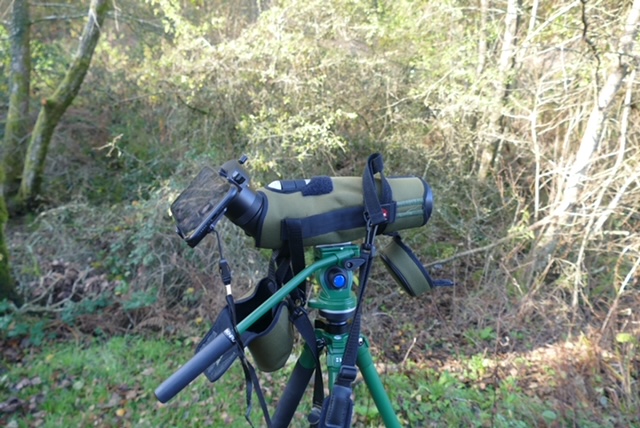
It's likely that phonescoping came about as the result of a happy accident. Someone, somewhere – or perhaps a few people all around the same time – discovered that it was possible to capture a magnified image by holding a smartphone up to the eyepiece of a spotting scope. Subsequently, this slice of serendipity resulted in a splurge of phonescoping adapters flooding onto the market.
At first, most manufacturers tended to produce a range of digiscoping phone cases which were each made to fit a specific smartphone. Over the years, as it has become more apparent that people are likely to change or upgrade their phones regularly, universal adapters have come much more to the fore. The advantage of this is that it means you don’t have to change your smartphone adapter every time you change your phone. And, right on cue, that’s where the Smartoscope Vario-Adapter comes in.
These days, there are a number of universal phone adapters out there. I own one myself and have had the opportunity to try a few variants over the years. Most work along very similar lines: you have a phone case with an adjustable clamp to hold your phone and then, attached to that, a round fitting with a hole in the middle.
You fit your smartphone into the case, line the phone’s camera lens up with the aforementioned hole then push-fit the whole affair onto your scope’s eyepiece. In essence, Smartoscope’s offering works in very much the same way but is a bit higher-priced than most.
So what sets this one apart from the competition?
First and foremost, I would have to say build quality. Straight out of the box, the Vario looks and feels like it’s a step or two above the alternatives. Smartoscope products are designed and made in Austria and, unlike the vast majority of adapters out there, this one boasts a body which has been crafted from aluminium. The other components are made from high-grade polycarbonate and have a definite air of quality about them.
Going back to the body for a second, it also sports some foam inserts which are designed to protect your phone when clamping it in place – a nice touch, in my view. A less obvious advantage is that it’s possible to keep your smartphone in its regular phone case whilst digiscoping. This does depend to some extent on the type of case you have – it wouldn’t work with a wallet-style case, for example – but definitely another piece of cleverness to add to the list.
The Vario looks like the most compact variable adapter I’ve seen and this is a definite advantage as it allows the unit to fit into a pocket more easily. Something which my existing adapter just doesn’t do. This does depend somewhat on the size of the pocket in question but I can confirm that the Smartoscope fits easily into the cargo pockets on a standard walking trouser. I should also mention that it comes with a lanyard which gives another option for carrying the adapter in the field.
Set Up and Compatibility
You will see from the above that, attached to the phone case itself, we have an arm. Smartoscope terms this the K30 Optics Rail and it can be adjusted for both length and angle and then locked in place by means of the large locking wheel.
Once your smartphone has been clamped into the case the next step is to line up the hole at the end of the K30 with your phone’s camera lens. Being able to adjust the position of the K30 means that you can also choose which lens you want to use if your phone has this option. This is a simple thing but potentially hugely advantageous for many prospective users so definitely worthy of note.

At the end of the K30 there is a thread onto which any one of a number of adapter rings can be screwed. Once in place, the adapter ring is then pushed onto the scope’s eyepiece - after you’ve attached and lined up your phone as described above, of course - and you’re good to go.
The Vario comes with the K30 rail as standard and it has a 30mm thread. This accepts Kowa adapter rings which allow instant compatibility with most Kowa scope eyepieces. I should mention that Smartoscope produces three other rails: the S15, S16 and Z13. The first two are compatible with Swarovski PA and AR adapter rings respectively; the S13 fits Zeiss Exolens adapters.
If you’re a Swarovski or Zeiss user and would prefer to keep the existing K30 rail, Smartoscope also produces three adapter plates which reduce the 30mm thread down to 15mm, 16mm and 13mm respectively. So, in essence, if you’re a Kowa user, Swarovski user or Zeiss user, Smartoscope has pretty much got you covered. Search through the SMARTOSCOPE VARIO Kits here >
Universal Compatibility
But what about the rest of us? What do we do? Well, nil desperandum because Smartoscope has us covered. Enter the UR-4 Adjustable Eyepiece Adapter. This simply screws onto the Opticsrail in the same way as the dedicated adapter rings do and, straight out of the box, will fit an eyepiece with a diameter of 63.7mm.
It sports an inner compression ring and, once the UR-4 has been pushed onto the eyepiece, said ring is tightened in place by means of four small adjustment screws. This fits straight onto some Kowa eyepieces ‘as is' but can also be used on smaller diameter eyepieces by means of three supplied rubber inserts.
These inserts vary in thickness - I’ll call them small, medium and large for clarity - and can be attached to the inner ring of the UR-4 in order to reduce the working diameter accordingly. They stay secure by means of double-sided adhesive tape and allow the UR-4 to be used with eyepiece diameters all the way down to 46mm. Once you’ve found the combination that works with your eyepiece you simply push the UR-4 (with Smartoscope and phone attached) onto the eyepiece and secure in place with the four adjustment screws.
In order to achieve a secure fit with my Leica 26x wide-angle eyepiece I used the medium and small inserts and can confirm that, once the screws had been tightened, the whole setup felt very secure indeed – much more so than anything else I’ve used, in fact. This is important because any sort of movement can cause real issues when phonescoping.
With some adapters, the weight of the phone will be enough to cause the whole thing to shift slightly even after it appears to be secure. This movement, even if minimal, can cause noticeable blacking out and shadowing of the image and anything which minimises or eliminates this movement is a real boon. Photos probably help describe the foregoing better than words can so here we are:
(And just to confirm, the Smartoscope can be used in either portrait or landscape mode)
Smartphone Digiscoping with the Vario-Adapter
Once I had the Smartoscope Vario-Adapter and UR-4 all set up to work with my iPhone XR and trusty Leica scope I set off to try some digiscoping. I’ve stated in other blog posts that I much prefer capturing video footage rather than stills (as I like to have a record of the bird doing whatever it was doing when I saw it) so, first up, we have this Moorhen/Little Grebe combination. When I initially lined the scope up on the Moorhen I hadn’t noticed the grebe so definitely one of those ‘two for the price of one’ moments.
Shortly afterwards, with the weather deteriorating and light levels beginning to fade, these bathing Mandarins caught my eye. Mandarins are flighty birds and these were about 120 metres away so being able to observe and capture video footage from distance without causing any disturbance was ideal. Given the distance and gloomy conditions, I was really pleased with this result…I suspect that a scope with a larger objective lens would have improved things considerably.
On a second visit to the same site (and in much brighter conditions) a Chaffinch and a couple of Blue Tits were joined by a showy Song Thrush.
The Song Thrush hung around for a while and I pulled these stills from video footage. There’s some subtle Chaffinch photobombing going on in the second image.
A Proper Upgrade
Whilst putting the adapter through its paces it soon became apparent that Smartoscope’s offering represented a genuine step up from anything I’ve used before. The adapter was noticeably quicker and easier to attach than any of the others and, once the UR-4’s adjustment screws had been tightened, the whole setup stayed very firmly locked in place with none of the movement which has proved to be a bugbear with some of the alternatives.
At this point, I should also give special mention to the locking wheel which holds the optics rail in the required position. The wheel operates very smoothly and, once tightened, it really does lock the optics rail down very securely. This is important because, having taken care to get everything properly aligned, you could really do with all elements staying put. It also meant that I was able to put the adapter away after a day in the field and feel confident that everything would still be set correctly for my phone when I wanted to go phonescoping again.
Smartoscope has clearly taken steps to address this potential issue at the source and the benefits, for me at least, were apparent right from the off: this is a very, very stable setup indeed! During the course of testing the adapter, I genuinely found myself WANTING to digiscope more frequently.
After musing upon this for a short while I came to the inescapable conclusion that my new-found speed and ease of setup and use were the catalysts for this. In other words, phonescoping with less faff. This is a good thing, particularly if your intended subject isn’t likely to hang around for very long – which tends to be most of them, in my experience.
What could go wrong?
So what about the downside? This definitely isn’t the lowest-priced variable phonescoping adapter out there but, as mentioned earlier, build quality is first rate and, ultimately, you get what you pay for. One slight concern I had centred on the UR-4 or, to be more specific, the four adjustment screws which serve to tighten it onto the scope eyepiece. When these are unscrewed they can come all the way out which means that there’s potential for any one of them to fall and get lost.
My feeling is that some sort of safety lock to eliminate the possibility of this happening might be a wise addition. Then again, you only need the UR-4 if you’re using a scope for which there is no dedicated push-on adapter ring so this is unlikely to be an issue for most potential purchasers.
The Best Variable Phonescoping Adapter
In conclusion, this is by far the best variable phonescoping adapter I’ve ever seen or used – and I’ve seen and used a fair few! The build quality is without equal, it’s quick and easy to fit, stays put once attached and, when used with either the UR-4 or one of the dedicated adapter rings, it should be compatible with just about any of the current crop of spotting scopes.
Phonescoping is most definitely here to stay and Smartoscope has produced an adapter which makes getting nice results just that bit easier. For anyone with any interest at all in capturing images or video footage via their smartphone and spotting scope, the Smartoscope Vario-Adapter should be right at the top of the list. Yes, it costs a bit more than the others out there but, as I said right at the start, you get what you pay for. And, with the versatility the Smartoscope Vario-Adapter offers coupled with the exceptional build quality, you’d only have to buy your phonescoping adapter once – right?!
So there we have it. I hope this blog has helped shed some light on what really is a class-leading product which does exactly what it says on the tin, and then some. When digiscoping was still in its infancy most birders would use a point-and-shoot camera or DSLR, often in combination with an undeniably Heath Robinson type adapter. These days, as camera phones just get better and better, it looks like phonescoping adapters continue to evolve along with them…and what we have here is the sleekest, fastest, most user-friendly option out there.
Until next time, Happy Birding!
Convinced Yet?
The Smartoscope Vario-Adapter and UR-4 Adjustable Eyepiece Adapter are available (separately) here:
- SMARTOSCOPE Vario-Adapter for Smartphones (inc. Opticsrail K30)
- SMARTOSCOPE UR-4 Adjustable Eyepiece Adapter
Read Next
- Kowa TSN-99A Prominar Spotting Scope Review
- Swarovski NL Pure 8x42 Binocular and BTX 35x115 Spotting Scope Kit Real World Review
- Celestron NexStar 8SE | Mobile Digiscoping
Thank you!
Thanks for taking the time to read our blog, we really do hope they help you out and answer some of your questions. If you still have some unanswered, then please feel free to get in touch with our team of experts.
We have a LiveChat option on our website and we can, of course, be contacted via our email, we're also on the end of the phone too! Read more on how to contact us here >
Want to write for us?
If you've got experience with producing content on photo, video and/or optics products or techniques then we would love to hear from you. Contact our blog editor, Bea, with a sample of your work at [email protected].
- By Martin Drew
- 29 Nov 2022




























































